Tai Chi: The Art of Yin and Yang

At its core, Tai Chi encapsulates the philosophy of yin and yang – the dichotomy symbolizing the primal opposition of the universe – the dark and the light, the passive and the active. The gentle and slow revolving gestures embody these opposing forces, integrating them to form a sequential rhythm. Laced with an air of calmness, each movement signifies a shift, a transition, blending the discrete forces into a spectral continuum, creating a perfect meditative ballet of tranquillity.
Cognitive Well-being and Tai Chi
As a holistic exercise, Tai Chi not only contributes to muscle flexibility and balance but also invigorates mental health. Each fluid segue in sequences compels the practitioner to stay centered, fostering mindful awareness. The interaction of one’s mindfulness with the environment and the self creates a serene symphony, calming the cognitive dissonance, aiding in stress management, and fortifying mental resilience.
Physical Benefits of Tai Chi
Beyond the spiritual plane, struts its signature slow and deliberate movements as an exercise regime as well. The flowing sequences stimulate core stability and foster balance, reducing the risk of falls, particularly in older adults. The emphasis on deep, meditative breathing coupled with controlled movements aids in enhancing cardiovascular fitness. It helps fortify the body against physical stressors.
The Journey to Inner Harmony
In essence, Tai Chi is a journey that espouses inner harmony. It paints a vivid picture of how self-awareness, embodied in the physicality of a martial art. It can lead to an enhanced state of mental and physical well-being. So, as you begin your journey, remember that each step, each breath, and each movement is a gentle caress to your soul. A step towards achieving inner balance and tranquillity.

